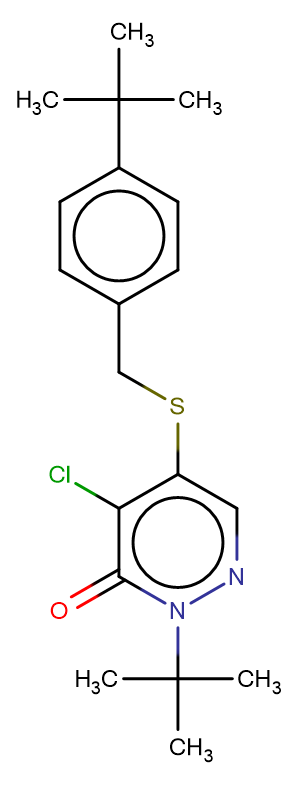
Pyridaben
CAS No. 96489-71-3
Pyridaben( —— )
Catalog No. M19913 CAS No. 96489-71-3
Pyridaben is a METI acaricide that inhibits mitochondrial electron transport at complex I (METI; Ki = 0.36 nmol/mg protein in rat brain mitochondria).
Purity : >98% (HPLC)
 COA
COA
 Datasheet
Datasheet
 HNMR
HNMR
 HPLC
HPLC
 MSDS
MSDS
 Handing Instructions
Handing Instructions
| Size | Price / USD | Stock | Quantity |
| 100MG | 37 | Get Quote |


|
| 200MG | Get Quote | Get Quote |


|
| 500MG | Get Quote | Get Quote |


|
| 1G | Get Quote | Get Quote |


|
Biological Information
-
Product NamePyridaben
-
NoteResearch use only, not for human use.
-
Brief DescriptionPyridaben is a METI acaricide that inhibits mitochondrial electron transport at complex I (METI; Ki = 0.36 nmol/mg protein in rat brain mitochondria).
-
DescriptionPyridaben is a METI acaricide that inhibits mitochondrial electron transport at complex I (METI; Ki = 0.36 nmol/mg protein in rat brain mitochondria).
-
In VitroCell Viability Assay Cell Line:Rat brain submitochondrial particles Concentration:0-10 μM Incubation Time:3 min Result:Led to a decrease of NADH-cytochrome reductase activity (complex I-III) and without modification of succinate-cytochrome c reductase activity (complex II-III) and of cytochrome oxidase activity (complex IV)Cell Viability Assay Cell Line:Rat brain mitochondriaConcentration:0-10 μMIncubation Time:3 min Result:Showed a marked and dose-dependent decrease in respiratory control in the presence of malate-glutamate as substrate (IC50=1.7 μM)
-
In Vivo——
-
Synonyms——
-
PathwayOthers
-
TargetOther Targets
-
RecptorNADH dehydrogenase(NADH:ubiquinone oxidoreductase|Electron transport complex I)
-
Research Area——
-
Indication——
Chemical Information
-
CAS Number96489-71-3
-
Formula Weight364.93
-
Molecular FormulaC19H25ClN2OS
-
Purity>98% (HPLC)
-
SolubilityDMSO: 50 mg/mL;Ethanol: 57 mg/mL;Water: Insoluble
-
SMILESCC(C)(C)c1ccc(CSc2cnn(c(=O)c2Cl)C(C)(C)C)cc1
-
Chemical Name2-(tert-butyl)-5-((4-(tert-butyl)benzyl)thio)-4-chloropyridazin-3(2H)-one
Shipping & Storage Information
-
Storage(-20℃)
-
ShippingWith Ice Pack
-
Stability≥ 2 years
Reference
1.Navarro A et al. Effects of rotenone and pyridaben on complex I electron transfer and on mitochondrial nitric oxide synthase functional activity. J Bioenerg Biomembr. 2010 Oct;42(5):405-12.
molnova catalog



related products
-
Biotin-Insulin Recep...
Biotin-Insulin Receptor (1142-1153)
-
3,8-Di-O-methylellag...
3,3'-Di-O-methylellagic acid reveals moderate antibacterial activity, it also shows strong DPPH radical scavenging activities with SC50 of 123.3 ug/mL.
-
Genipin
Genipin is an active aglycone derived from an iridoid glycoside called geniposide, which is found in the fruit of Gardenia jasminoides Ellis.



 Cart
Cart
 sales@molnova.com
sales@molnova.com


